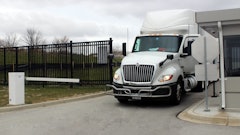More than 550 facilities in 22 countries use voice technology in their day-to-day operations. Though about 90 percent of those facilities use voice for picking exclusively, a growing number of them are taking their systems beyond basic order selection.
Mitchell Grocery, a wholesaler based in Albertville, AL, is one such company. Though about 100 order pickers at the company’s three warehouses use the VoiceLogistics system from Voxware, Lawrenceville, NJ, in their daily routine, another 20 workers use it in the loading of up to 80 truckloads per day. Mitchell Grocery also uses voice in replenishment and consolidated picking for slow-moving items stored in another facility.
At the loading dock, VoiceLogistics tracks and confirms that all pallets are successfully loaded to the proper trailer and alerts operators to any missing items. The system also produces a printed manifest, which speeds the identification of specific items in each shipment and improves Mitchell Grocery’s credibility with its customers.
Each week, Mitchell Grocery delivers more than 500,000 cases of dry groceries, milk, produce and ice cream to more than 250 independent grocery retailers in the Southeast. Since deploying the system in late 2005, the company has noticed a 50 percent improvement in the loading accuracy of those shipments, according to David Mitchell, its president. “We have introduced more precision into the loading operation, which has lowered costs and improved customer satisfaction,” he says.
And with a high volume of perishable products in its 16,000-SKU inventory, the company can ill afford to have product waiting for too long on a loading dock before being loaded into a refrigerated trailer.
That is also the case for Reed Boardall, Britain’s largest frozen food distributor, serving such major retailers as Tesco, Asda, Sainsbury’s, Safeway and Morrison’s. Workers at Reed Boardall’s 426,000-square-foot warehouse in Boroughbridge, England, also use voice technology for loading, verification and yard management applications.
“Our vision for voice technology goes beyond the simple picking solutions,” says Keith Boardall, its group managing director. “We view voice as far more than an alternative method of capturing data. It is a means to optimize the contribution of each worker across a wide range of activities.”
Inside the warehouse, which moves 7,000-8,000 pallets of food each day, Voxware’s VoiceLogistics helps workers deliver pallets to the exact dock where a trailer is waiting for them. As a worker picks up a prepared pallet for loading, he reads an attached voice ID number into the system, which recognizes the pallet number and lets the worker know which of the 40 loading docks requires that particular pallet.
VoiceLogistics also is used to verify all the goods that go into and out of the warehouse. For every pallet that goes in or out, workers use the system to record things like temperature, case count, best-before dates and customer or supplier identification numbers.
One of the first adopters of voice for applications beyond picking was Dunkin’ Donuts, which has also brought the technology out to loading, receiving and cycle counting at its Mid-Atlantic Distribution Center (MADC) in Westhampton, NJ. The company is likely to expand the use of its voice system at the MADC even further to include put-away, replenishment and yard management within the next few months, and is even looking at bringing similar applications on line when it brings voice to another distribution center in Clermont, FL.
Though voice systems providers have been touting their systems for warehouse applications other than picking for years, it looks like it’s finally starting to take hold, especially in the food industry, say system providers and industry insiders alike.
Pick To Start
Most companies that have already implemented voice in other warehouse applications started in picking, and as they saw a return on their investment there, they expanded it to other areas.
“Our experience with voice-driven picking was so extraordinary, we sought to leverage the value of voice throughout the entire warehouse,” says Warren Engard, director of distribution operations at Dunkin’ Donuts’ MADC. “It’s working very well for us. We knew right from the beginning that we wanted to more [than just picking].
“By extending voice to the rest of our material handling applications, we improved our return on investment and increased productivity,” he continues. “We have also increased our product availability, enhanced inventory control, improved our ability to respond to our franchisees and better utilized our workforce.”
That is typical, says Jefferson Barr, Voxware’s director of marketing communications. “In warehousing, 40 percent of the labor is in picking, so the biggest ROI [for voice] is there, but you can migrate it fairly easily to other applications as well,” he says. “Other applications also contribute to labor costs, and the ROI may not be as rapid, but why not roll voice out to them if the infrastructure is already there?”
At St. Louis-based FKI Logistex North America, product managers are seeing the same thing. “EasyPick was originally for full cases, and now it is going into split-case picking. It started as something dedicated just to picking, but is now going into anything that surrounds it. Replenishment, cycle counting, etc., are also part of the software,” says Bill Hubacek, product director for order fulfillment products.
“In logistics, there are applications that go together, like picking and replenishment, receiving and put-away, and if you are doing one with voice, you can certainly go with it for the other,” adds Mike Smith, business development manager at LXE, Norcross, GA.
“Applications [for voice] abound,” says Ken Ackerman, president of KB Ackerman Co., a Columbus, OH-based consulting firm. “Order selection is the most widely used application, but the technology is also adept at handling receiving, put-away, replenishment, sortation, truck and line loading and cycle counting.”
Though loading, put-away and replenishment are among the most common non-picking applications to use voice today, other applications where voice is making inroads include temperature tracking, quality control and pallet transfers. Beyond that, many feel that in the not too distant future the technology will also work its way beyond the four warehouse walls into yard management and all the way out to the customer site through proof of delivery by truck drivers.
These applications “all typically have a what and a where that has to be collected and sent, and voice can do that,” maintains Smith. “Whenever you’ve got something that needs to be validated, voice can have a role, and all the technical advantages that voice has will come through.”
Mike Miller, director of strategic consulting, sales and professional services at Pittsburgh-based Vocollect, feels that yard management and proof of delivery are really the most ripe for voice technology.
“With yard management, a lot of it is now manual and walkie-talkie based, but it doesn’t have to be. The yard is really the same as the inside of a warehouse; you’re just dealing with a different set of SKUs—trucks and trailers instead of cases and pallets,” he says. “On deliveries, the driver can let the system know when he gets to a location and it can work with him on what is supposed to be taken off and where it is in the truck. The truck is really a mini warehouse on wheels.”
The four basics of voice, he adds, are telling a worker where to go, what to get, how many to get, and where to put them, and any application that centers around that same information is ripe for voice.
Receive With Caution
But of all the applications that voice can accommodate today, the one where there is still a lot of disagreement is receiving because of the high volume of information that comes in at that stage of the warehousing process.
Discussion in the industry centers around what role voice-based systems will play in the entire process, and whether voice can adequately do the job of a scanner or radio frequency identification (RFID) tag reader.
“In replenishment of a forward picking area, it makes sense. In cycle counting, it also makes sense. In receiving, there’s a lot of barcode entry and data verification that goes on. Speaking an 18-digit barcode into the system is not desirable,” says FKI Logistex’s Hubacek.
“Six to eight digits is probably the maximum that you want to do with voice,” adds LXE’s Smith. “Beyond that, the opportunity for errors goes up exponentially. Then, there’s no time savings because you have to go back, correct and repeat.”
But, he acknowledges that especially in the food industry, there are a lot of products—in some cases as much as 15 percent to 20 percent—that come into warehouses without any barcodes or RFID tags at all. Those products can be entered into the system with voice, “as long as there is enough activity to justify the expense,” he says.
But, for the most part today, “people are still reluctant to go with voice for receiving because it’s better done with a scanner,” Voxware’s Barr also concedes. “It’s a lot more difficult to say a long set of numbers than to scan them in.”
Vocollect’s Miller agrees. “Sometimes scanning is required, but voice is substantially faster than other data entry means, such as a keyboard, which often now goes hand in hand with receiving,” he says.
Where voice can help, though, is in processing receipt of a large number of the same item, according to Dunkin’ Donuts’ Engard. “When doing multiple quantities of the same item, it would be great if the guy could say the last four digits [of a product identification number] and then say ‘enter 50’ rather than scanning an item 50 times,” he says.
To that end, Dunkin’ Donuts is working with its warehouse management system provider, Dallas-based Retalix USA, to streamline voice processes for receiving. “The WMS creates a pallet ID in advance, but it is not incorporated into the system until it is scanned,” Engard explains. “We need to work with the WMS so that it retains that ID in the system without scanning so that the picker only has to say the last four numbers or so to enter it into the system.”
Until that process is streamlined, though, just about every voice technology provider today is recommending a multi-modal approach to receiving applications, combining voice, RFID and scanning technologies into one system.















